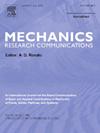User-friendly Gotoh’s 1977 fourth-order yield function
IF 2.3
4区 工程技术
Q3 MECHANICS
引用次数: 0
Abstract
The homogeneous polynomial of fourth order with nine coefficients as originally developed by Gotoh in 1977 is a simple non-quadratic yield function that can model fairly well an orthotropic sheet metal under both uniaxial and biaxial stress states. Unlike Yld2000-2d yield function with eight anisotropic material parameters, however, a Gotoh’s 1977 yield function calibrated by the conventional direct method may not be convex and has thus not been as widely used in sheet metal forming analyses. Four user-friendly methods to develop a strictly convex fourth-order yield function are presented and evaluated in this study. The first three methods decompose Gotoh’s 1977 quartic yield function into a sum of two or more fourth-order polynomials whose convexity may be rather easily established. The last method uses a certain algebraic certificate of sum-of-squares (SOS) convexity to verify directly the convexity of a calibrated Gotoh’s yield function. More importantly, a least-square minimization (with algebraic convex constraints as needed) may also be readily implemented using these methods towards parameter identification of a Gotoh’s yield function with guaranteed convexity. These four methods were subsequently applied to verify the convexity of many calibrated Gotoh’s yield functions reported in the literature. Convexity-constrained parameter identification was also carried out successfully using a set of twelves experimental inputs for one aluminum sheet and one steel sheet. Except the method based on a sum of squares of Hill’s 1948 quadratic yield functions, results of our current study showed that other three methods achieved nearly equal effectiveness. As the SOS-convex method is easiest to use, it is thus recommended as the preferred user-friendly method in developing convex Gotoh’s yield functions for industrial sheet metal forming applications.
用户友好的后藤1977年的四阶屈服函数
Gotoh于1977年首次提出的四阶九系数齐次多项式是一种简单的非二次屈服函数,可以很好地模拟单轴和双轴应力状态下的正交各向异性金属板。然而,与具有8个各向异性材料参数的Yld2000-2d屈服函数不同,由传统直接方法校准的Gotoh 1977屈服函数可能不是凸的,因此没有广泛应用于钣金成形分析。本研究提出并评估了四种用户友好的方法来建立严格凸四阶屈服函数。前三种方法将Gotoh 1977的四次屈服函数分解为两个或多个四阶多项式的和,这些多项式的凸性很容易建立。最后一种方法利用平方和(SOS)凸性的代数证明,直接验证标定后的Gotoh屈服函数的凸性。更重要的是,使用这些方法也可以很容易地实现最小二乘最小化(根据需要使用代数凸约束),以确定具有保证凸性的Gotoh屈服函数的参数。这四种方法随后被应用于验证许多校准Gotoh的屈服函数在文献中报道的凸性。采用一组铝板和一组钢板的12个实验输入,成功地进行了凸约束参数辨识。除了基于Hill 1948年二次屈服函数平方和的方法外,我们目前的研究结果表明,其他三种方法的效果几乎相同。由于sos -凸方法是最容易使用的,因此推荐作为首选的用户友好的方法,在开发凸Gotoh的屈服函数为工业钣金成形应用。
本文章由计算机程序翻译,如有差异,请以英文原文为准。
求助全文
约1分钟内获得全文
求助全文
来源期刊
CiteScore
4.10
自引率
4.20%
发文量
114
审稿时长
9 months
期刊介绍:
Mechanics Research Communications publishes, as rapidly as possible, peer-reviewed manuscripts of high standards but restricted length. It aims to provide:
• a fast means of communication
• an exchange of ideas among workers in mechanics
• an effective method of bringing new results quickly to the public
• an informal vehicle for the discussion
• of ideas that may still be in the formative stages
The field of Mechanics will be understood to encompass the behavior of continua, fluids, solids, particles and their mixtures. Submissions must contain a strong, novel contribution to the field of mechanics, and ideally should be focused on current issues in the field involving theoretical, experimental and/or applied research, preferably within the broad expertise encompassed by the Board of Associate Editors. Deviations from these areas should be discussed in advance with the Editor-in-Chief.

 求助内容:
求助内容: 应助结果提醒方式:
应助结果提醒方式:


